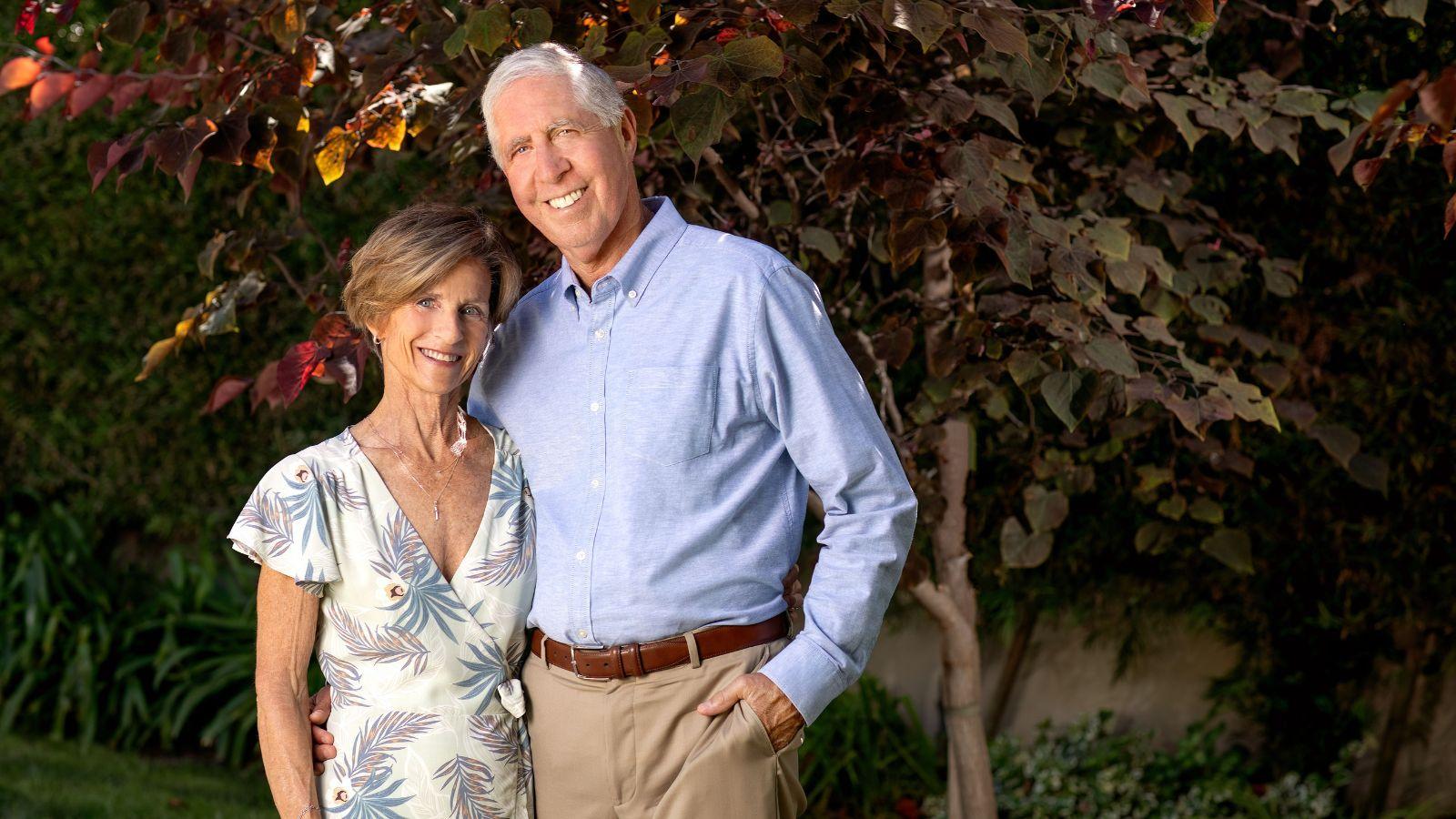
Written by Diane Krieger | Photographed by Michael Neveux
More by serendipity than by design, Craig Leach turned out to be the captain Torrance Memorial needed to safely navigate an era of health care headwinds. Skillfully dodging regulatory icebergs, economic cyclones and info-tech minefields, this uniquely gifted and committed hospital commander ends his nearly 40-year voyage with unimagined treasure in the cargo hold.
October 31 is Leach’s official last day as CEO. High on the list of his accomplishments (though Leach refuses to take credit) is the monumental $350 million in philanthropy accumulated on his watch by the Torrance Memorial Foundation.
“I don’t consider myself a great fundraiser,” Leach says with characteristic modesty. “The fundraising that’s gone on here has been 1% me and 99% Laura Schenasi’s team, the foundation board and community generosity. I’m just a bit player in that whole process.”
Schenasi begs to differ. “Craig is a big, big part of fundraising because he creates the hospital people want to support,” says the longtime executive vice president of the foundation.
Feels Like Family
Indeed, the “feels-like-family” culture that defines Torrance Memorial is at the root of the hospital’s excellence. And Leach is the compass for that signature culture.
“He’s a rare combination: modest, generous and sincere. He has the highest character, the highest integrity, and he sets a great example for others,” says Greg Geiger, chair of the board of trustees at Torrance Memorial and a principal at Westport Capital Partners.
“Craig’s leadership has made everybody better. The doctors are better, the administration is better. As a team, we’re all better,” says oncologist David Chan, MD, who worked closely with Leach in developing Torrance Memorial’s world-class cancer program.
“Craig cares so much!” says physical therapist Tami Ramsey, a hospital staffer for 26 years. “He is passionate about Torrance Memorial. He’s devoted. He’s authentic. He treats us like family. He’s just a superior human being. And his dedication to excellence of care trickles down. I am so grateful to be part of the Torrance Memorial culture Craig has cultivated.”
The Early Days
A native son of the South Bay, Leach grew up in the Hollywood Riviera and attended St. Lawrence Martyr School, then Bishop Montgomery High School. His dad, Dave, was a science teacher at Redondo Beach High School. His mom, June, stayed home with their five kids.
When Leach joined Torrance Memorial in 1984, he was only 28 years old. A CPA with an accounting degree from Loyola Marymount University, he’d gone to work for Deloitte in Downtown Los Angeles. By some good fortune, he was asked as a rookie to audit several hospital clients. Intrigued, Leach wanted to dig deeper, so he accepted a comptroller job with Centinela Hospital in Inglewood. Three years later, he moved to Torrance Memorial as director of finance.
And never left.
Bold Moves
At the time, Torrance Memorial had roughly 1,000 employees. The campus was just three buildings. After skating on thin ice in the 1970s, the hospital’s books were balanced by the ’80s but looked shaky again when the California legislature mandated costly seismic upgrades for hospitals following the 1994 Northridge earthquake.
The whole medical marketplace was reinventing itself. Private physicians—overwhelmed by computerized billing, insurance complexity and government regulations—were running for cover under big-tent health care systems. Struggling small hospitals were being snapped up by large ones. The South Bay population was growing, and a new generation of patients wanted ambulatory services in their local communities.
Leach advocated for bold moves, laying the foundation for Torrance Memorial’s present-day stability and excellence. He was promoted to senior vice president in 1996, then to chief operating officer in 2001 and president/CEO in 2005.
The digital revolution in health care, the 2008 financial crisis, the advent of the Affordable Care Act and a once-in-a-century deadly pandemic all happened on his watch. Yet Leach leaves behind a record of stunning expansion and surging excellence.
The data points are eye-popping: a five-fold increase in staff; the doubling of hospital-owned land; two new patient towers on the main campus and several community-based ambulatory care centers sprinkled across the South Bay; the aforementioned $350 million in philanthropy; and a trailblazing partnership with Cedars-Sinai Health System.
“He’s the Warren Buffett of hospital administration,” says retired cardiologist and current Torrance Memorial Foundation board chair Mark Lurie, MD. “My wife and I call him the GOAT—the greatest-of-all-time CEO. I can’t say enough good things about Craig. And usually you don’t hear that from a physician about an administrator.”
A Friend to All
When Lurie began his 38-year career at Torrance Memorial, his brother-in-law, a seasoned hospital physician, warned him to steer clear of administrators. Lurie blithely ignored the advice, shouldering a series of program directorships in cardiology, culminating in the role of hospital chief of staff. Physicians and administrators don’t have to be adversaries, Lurie discovered—at least not at Torrance Memorial.
“Craig is on the side of the doctors and the nurses. He never steps in your way or tries to stop you. He’s your partner, and he has your back,” says Lurie, who retired from practice in 2019 and stepped down earlier this year from the medical directorship of the Lundquist Lurie Cardiovascular Institute. He currently is in his 12th year as foundation president.
Building confidence and loyalty has been a key factor in Leach’s success as a leader. He earned the trust of hospital stakeholders—from groundskeepers and cafeteria workers to physicians and nurses to volunteers and major donors—by engaging with them honestly, respectfully and warmly as individuals.
His door is always open to anyone who knocks. He returns phone calls and responds to emails promptly. He walks the hospital floors at least two mornings a week, greeting everyone by name—an amazing feat given Torrance Memorial’s 5,000-strong workforce. The hospital is currently the city’s largest private employer.
“He’s just very human, and he makes people feel good about themselves,” says philanthropist Melanie Lundquist, who together with her husband, Richard, has invested $100 million in Torrance Memorial since 2005. “Craig’s presence is always felt by the employees. They love working there.”
She speaks from personal knowledge, having worked a Thursday volunteer shift at the hospital’s front desk from 1985 to 1996. Feeling a connection with Torrance Memorial, Lundquist’s volunteerism flowered into philanthropy. “I knew Torrance Memorial was a good place,” she says. “I just knew that’s where I wanted to be.”
Leach’s sincerity is a big part of that connection. “Craig really sees you,” says philanthropist Priscilla Hunt, also a major donor to Torrance Memorial. “Some people, when they’re talking to you, at the same time they’re looking around. But when Craig is talking to you, it’s eye-to-eye, one-on-one.”
Torrance YMCA president Steve McAller recalls his first tour of the hospital with Leach as a guide. “It wasn’t just a tour. It was like he was telling me: ‘Welcome to my home. Welcome to my neighborhood.’ Craig knew every single person and had a genuine relationship with each one of them. He takes great pride in the community, and the pride goes both ways.”
A Humble Unicorn
Leach’s spouse confirms this. “There is nothing fake about Craig. Nothing. He’s a genuine, humble person. A unicorn,” says Judy Leach, his wife of 45 years. A retired nurse, she worked under cardiology director Ben Rosin, MD, for many years in the basement of the old tower and would regularly grab lunch with her husband at the cafeteria.
Close friends since high school, their relationship blossomed into romance during college, and they were married on Leach’s 23rd birthday. While Leach poured his lifeblood into the hospital, he always put his family first. “I never felt I was married to Torrance Memorial,” Judy says.
In the early years, she worked a 12-hour nursing shift on Saturdays, which left Craig in charge of David, Paul and Daniel—their three young sons. As the boys grew older, Leach made time to coach each of their soccer and baseball teams, seldom missing a game. Now grown, the Leach boys—together with their wives Kristen, Nina and Taryn—have given their parents seven (soon to be nine) beautiful grandchildren. All live in the South Bay.
Judy says looking back, she never anticipated her husband’s ascending to CEO. “It’s a tough position, but Craig made it seem so easy. He rarely came home from work in a bad mood and seldom talked about it.”
As Judy reminisces, her voice catches. She pauses to bring her emotions under control. “I’m not usually like this,” she says. “Craig, by the way, cries at everything.”
Leach admits to this weakness. Early in the pandemic, strong emotions kept taking him by surprise as the crisis teams, headed by chief medical officer John McNamara, MD, and chief nursing officer Mary Wright, RN, pivoted day by day, sometimes hour by hour.
“It was a very special time in terms of people coming together and figuring out how to make this place work for the difficult task in front of us,” Leach says.
A Bold Vision
The emotional pinnacle in Leach’s professional life was the opening of the Lundquist Tower. He vividly recalls watching through misty eyes as the first patient was wheeled from the old tower to the new one. The faces of “so many good people” who had labored for years to make it happen showed unmistakable pride.
The Lundquist Tower came in early and under budget. Good timing and shrewd planning had saved about $30 million when interest and bond rates sank in the 2008 financial crisis and construction costs responded to the bear market.
Leach has been accused of prescience in other bold moves he’s made over the years—for example, building out a sophisticated Torrance Memorial physician enterprise and affiliating with Cedars-Sinai to expand access to more services for the South Bay. Leach shrugs off such foresight as a function of having been around long enough to know bone-deep what might be best for the hospital.
The high turnover generally seen in health care administration is a major flaw in the system, he believes. “Stability helps breed culture and a shared vision for the future,” he says. “If you have lots of people reinventing the wheel every couple of years, it’s hard to create a vision.”
Leach’s vision begins with a fierce loyalty to Torrance Memorial. As an up-and-coming executive of a booming regional hospital, he could easily have moved up and out.
“Craig was highly recruitable,” says Sally Eberhard, a retired Torrance Memorial executive whose career overlapped with Leach’s for 35 years. “But it was always clear Craig wasn’t going anywhere. He grew up in this community and was devoting his career to Torrance Memorial. His values were to stay committed to building the best hospital system he could imagine for the South Bay.”
A Smooth Transition
Even as he approaches retirement, Leach is leaving nothing to chance. He set the stage for a smooth transition in 2021 when he recruited and onboarded his chosen successor, Keith Hobbs.
“My retirement date was known from the day Keith got here,” Leach says. “I thought it would be great for him to have two years to really get to know the people, fit into the culture of the organization and then hopefully be the person who takes over.”
As CEO of the USC-affiliated Verdugo Hills Hospital, Hobbs already had five years of leadership experience running a medical center as part of a larger health system. Hired as executive vice president, Hobbs was promoted to president this past February and will step into the CEO role in November.
Asked what advice Leach would give his successor, he says: “Build on Torrance Memorial’s culture of being compassionate like family; keep up the positive relationship with doctors; and stay engaged with your exceptional management team and staff. I know Keith can do that, and I think he’ll be very successful.”
Asked to sum up his legacy, Leach highlights a few landmark achievements: spearheading the Cedars-Sinai affiliation; building the Lundquist Tower; and creating the Torrance Memorial physician enterprise system. The build-out of the Hunt Cancer Center and the El Segundo medical facility also rate high on the list.
“Craig has built a formidable organization,” says Thomas M. Priselac, president and CEO of Cedars-Sinai Health System. The two men are longtime friends who served for decades on the boards of the California Hospital Association and the Hospital Association of Southern California. Their mutual respect and trust eased the way for the innovative affiliation structure that will help ensure Torrance Memorial is around 100 years from now.
Some of the seeds Leach planted have yet to germinate. Back in 2008 when the “for sale” sign went up at the old Honeywell turbocharger plant, Leach jumped at the chance to acquire 16 acres of precious hospital-adjacent property. With the Lundquist Tower underway, it was too soon to build there.
So Leach bulldozed the old factory and paved it for use as overflow parking. (Free parking was something Torrance Memorial had promised to the city years before, and Leach intends to honor that promise.) But in the long term, those 16 acres will be the site for another major hospital expansion.
Then last year, when the medical buildings at 3400 and 3440 Lomita Boulevard came on the market, Leach encouraged Priselac to purchase them. That’s another 7 acres of property now owned by a sister institution.
“I don’t know any hospital in L.A. County that has 23 acres of adjacent property to develop for the next century,” says Leach. “And we do! We are in good shape to grow and serve this community for the next 100 years.”
A Philanthropist’s Eye View
Laura Schenasi recently took a call from a stranger who, it turned out, wanted to donate $1.5 million. “I’d never met the man before,” says the hospital’s chief fundraiser.
The episode illustrates how Torrance Memorial’s authentic, feels-like-family culture—combined with excellent care—is a powerful driver of philanthropy. A year earlier, that donor had arrived at the ED in critical condition. Within minutes, he was diagnosed with congestive heart failure and soon thereafter rushed into emergency surgery for a transcatheter aortic valve replacement.
As he recovered, passing through the intensive care and progressive care departments, a desire to support the hospital welled up. If it weren’t for Torrance Memorial, he later told Schenasi, he would have died.
“This happens over and over again,” says retiring CEO Craig Leach. “People come to the emergency department, receive phenomenal care, and then a light bulb goes on. The doctors and the nurses here at the hospital are part of our philanthropy process without even knowing it.”
Asked why people support Torrance Memorial, Schenasi says donors invariably tell her: “It’s the way your staff took care of us.” Schenasi shares, “Sometimes it’s end-of-life care. We can’t save everybody’s life. But whatever the outcome, families realize the kindness and strategic thinking that go into caring for our patients, and they are grateful.”
Such windfall gifts haven’t led to wastefulness or complacency under Leach’s stewardship. “People want to support fiscally well-managed organizations,” Schenasi says, “and Craig runs a lean, mean working machine.”
Melanie and Richard Lundquist know that firsthand. They have donated about $100 million since 2005, and “we’re not done with Torrance Memorial yet,” say the Lundquists, who are Giving Pledge signatories and have appeared three times on “The Philanthropy 50,” an annual list published by the Chronicle of Philanthropy that names America’s top 50 most generous philanthropists.
“Because of Craig and his team, we have been able to realize the philanthropist’s dream of being able to make a big, big, big, big difference in human lives,” says Melanie Lundquist.
All their gifts to Torrance Memorial have been unsolicited, but the Lundquists are very hands-on donors who ask to be kept in the loop. “Philanthropists can make mistakes, and we’ve made a few,” Melanie Lundquist says. “You want to find organizations and people who will be incredibly good stewards of your philanthropic dollars and get the most impact for your investment. And that’s exactly what Craig has been able to do. We’re going to miss him tremendously.”
Lundquist appreciates how Leach always responds to her questions and concerns with hard data, not airy reassurances. “He makes us a partner. Torrance Memorial earned our trust, and we earned their trust too. It’s a two-way street.”
She adds, with a laugh: “They’re always busy thanking us, but we should be thanking them—because without them, we’d just be throwing our dollars at the wall to see what sticks.”
“With Craig, you don’t have to worry about, ‘Hey, where’s my money going?’ I know that everything I donate is 100% going to a hospital program and what they intend to do with it,” says philanthropist Priscilla Hunt. Her initial $34 million gift helped fund the renovation and renamed the North Patient Tower, now the Donald and Priscilla Hunt Tower. The Hunt Radiation Oncology Center followed, and in 2019 the Hunt Cancer Center had its ribbon cutting.
Hunt had personal reasons for supporting the hospital. Her husband Donald, then 96, received superb end-of-life care in 2017. So had her sister, Dolores. Terminally ill with cancer, she’d been given only weeks to live. It was April, and Dolores desperately wanted to see her first grandchild, due in June.
Oncologists at another hospital had refused further treatment as pointless. So the Hunt family consulted oncologist Hugo Hool, MD, at Torrance Memorial. “He told us: ‘I’m not God, but I will try my very best,’” Hunt recalls. With aggressive chemotherapy, Dolores lived to see not only her granddaughter’s birth but the child’s 1st birthday.
Hunt witnessed another life-saving miracle when she referred a receptionist in her company to Torrance Memorial. The young woman had been diagnosed with stage 4 cancer. She weighed just 86 pounds and was bracing for death. That was seven years ago, and she still works at Hunt Enterprises.
“The Hunt Cancer Center does so much good,” says its benefactor, and she lays much of the credit at Leach’s door.
Exit Plan
Craig Leach officially retires on Halloween. Asked what he’ll do the morning after, he says: “I’ll probably go down for a swim after sleeping in late, then come home and have my toast and peanut butter with a glass of milk”—his breakfast routine since early childhood.
He looks forward to spending more time with friends, playing golf and exercising to keep in shape. He’ll also stay involved with Torrance Memorial, continuing to serve on the board of trustees, which should bring him on campus regularly.
He’ll remain on the Torrance YMCA board too. “I love that organization. They have a beautiful mission,” Leach says. He’s on the lookout for new volunteer opportunities—“maybe actually get my hands dirty,” he says.
The Leaches have ambitious travel plans. Last summer, they thoroughly enjoyed a river cruise from Normandy to Switzerland, and more adventures loom on the horizon. “I’d like to do an Israel trip, and I’d like to go to Spain and Portugal,” he says. “I want to explore places in the United States I’ve never visited, like Yellowstone and the Tetons. Judy is a big walker. Anything that involves hiking or walking, she would do in a heartbeat.”
Spending quality time with his grandchildren is high on Leach’s post-retirement to-do list. “I would love to pick them up at school or take them to the beach while they’re still young enough to like having me around,” he says, smiling.






